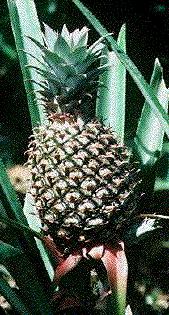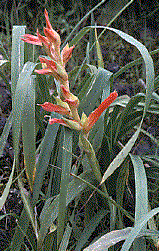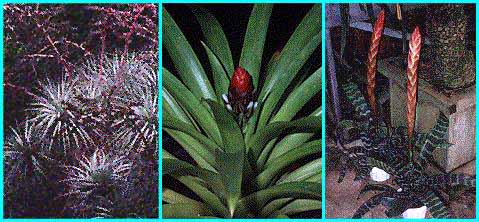

The Bromeliflorae, as here treated, are a group of monocots comprising two families: the Bromeliaceae with 45 genera and about 2000 species, and the Rapateaceae with 16 genera and 80-100 species. Both the Rapateaceae and Bromeliaceae are perennial herbs native entirely to the New World, but each with a single species in West Africa (Maschalocephalus sp. and Pitcairnia feliciana, respectively). This distribution suggests that the two families appeared at about the time when Africa and South America were drifting apart.
Fossil bromeliads are rare, and though a Late Cretaceous fossil from Kansas, and several Tertiary fossils from central and eastern Europe have been described as bromeliads, this interpretation has not been well-supported (see Smith 1974). Additionally, the spiny-leaved Karatophyllum bromelioides, recovered from 30 million year old deposits in Costa Rica, has also been compared to the bromeliads, but the preservation is insufficient to make a definitive identification. There are no known Rapateaceae fossils.
The Rapateaceae have often been considered close relatives of the Commeliniflorae, based on what are likely plesiomorphic characters shared between the groups. Recent studies suggest a closer relationship with with the Bromeliaceae -- in fact both groups have leaves which wrap around their stems, and both produce their flowers in tight clusters. Some of the large terrestrial bromeliads, believed to be closely related to the first bromeliads, look very much like agaves or grasses, and may be mistaken for those groups by the inexperienced. Consider the grass-like leaves of Pitcairnia karwinskyana, pictured at right.
Bromeliads today are grown as ornamentals, such as Guzmania and Vriesia, and for food, such as the pineapple. In addition, pineapple stems are a source of the commercial protein-digesting enzyme bromelain, used as a meat tenderizer. The presence of this enzyme in fresh pineapple is the reason that it cannot be used in gelatin molds, which rely on congealing proteins. Bromelain is now being marketed as an effective anti-inflammatory agent under the name Ananase; the protein-digesting qualities help to increase blood flow and reduce swelling.
The pineapple (Ananas, shown at left) is the only bromeliad commonly cultivated for food. Though often associated with Hawaii, it is not native there, but was introduced as a crop. The fruit of the pineapple is a multiple fruit, fromed when a whole cluster of flowers mature as individual fruits. Each of the diamond-shaped sections visible on a pineapple comes from a separate flower. The core of the pineapple then is actually the stalk of the plant, which continues to grow and produce leaves which are found at the pineapple top. This top portion may be planted, producing a new pineapple plant -- a very important property, since commercial pineapple fruits do not contain seeds.
There are three subfamilies of Bromeliaceae: Pitcairnoideae (terrestrial, often with spiny leaves), Bromelioideae (terrestrial or epiphytic, "tank" bromeliads, with an inferior ovary), and Tillandsioideae (epiphytes, including Vriesia and Spanish "moss"). The three subfamilies are quite distinct from each other, and there is general agreement on this classification, though the genus Navia is sometimes considered to be a separate subfamily because of a number of unusual features, many of which are shared by the Rapateaceae.
The members of the Pitcairnoideae are all terrestrial, that is they grow rooted in soil the way that we expect plants to do. Leaves often have spiny edges, and may be thick and fleshy. Some of these Pitcairnoideae look very much like agaves, and live in the same kind of dry environment occupied by agaves. This group of bromeliads is considered to represent the first bromeliads, meaning that they both look like them, and are probably quite closely related. This is in contrast to the other two families, which have evolved many novel characteristics.

Bromeliad groups : The picture above shows representatives of the three bromeliad subfamilies. From left to right, Pitcairnoideae (Puya, a large terrestrial desert bromeliad); Bromelioideae (Guzmania, a terrestrial "tank" bromeliad); and Tillansioideae (Vriesia, an epiphytic tropical bromeliad).
The other two families include many epiphytes, and most of their members absorb their water and nutrients through their leaves rather than through roots. They are able to do this because their leaves are covered by permeable scales, which absorb water and nutrients when they are moistened, but seal themselves as they dry out, preventing water loss. The stripes visible on the leaves of Vriesia, shown above at right, are produced by variations in the types of scales. Also, many of these bromeliads have leaf bases which overlap each other around the base, forming a tank which collects and holds water. These tank bromeliads are often important for tropical frogs whose eggs and tadpoles develop there. Because of these bromeliads, many tree frogs spend their entire lives in the tops of tropical trees.
Bromeliads are also a group which, like their grass relatives, have developed an alternative form of photosynthesis, called C4 photosynthesis. This modification of the more usual biochemical pathways makes them more efficient users of water. This might not seem to make sense for plants living primarily in tropical forests, but in the treetops where many bromeliads live there are only limited amounts of water and a real danger of drying out. Also, many tropical forests on the western coast of South America receive rather little rainfall, and most precipitation comes in the form of fog. Thus, water must be obtained directly from rainfall or from the air but is otherwise limited, and as a result many epiphytes experience water-stress.
The only bromeliad to occur north of the New World tropics is Spanish "moss", which is neither Spanish nor a moss. Like many other bromeliads, it is an epiphyte, but because of its long scaly stems and reduced flowers, it does not look like them. Spanish moss is common in the southeastern United States where it hangs in dense grows from many trees. The tough stems have been used in upholstery and Cajun architecture.
For additional information about the Bromeliflorae, try:
For a really amazing set of links and information about bromeliads, try the home page of the Florida Council of Bromeliad Societies by Michael Andreas.
Visit the DELTA descriptions of the Bromeliaceae and Rapateaceae for technical information. You can also view images of Bromeliaceae at Wisconsin, at Texas A&M, and on Charlie's Web.
And don't miss these fine sites!

Sources:
D. H. Benzing. 1980. The Biology of the Bromeliads. Mad River Press, Eureka, CA, USA.
Lyman B. Smith. 1974-1979. Bromeliaceae. Flora Neotropica 14(1-3).

